NavSource Online: Submarine Photo Archive
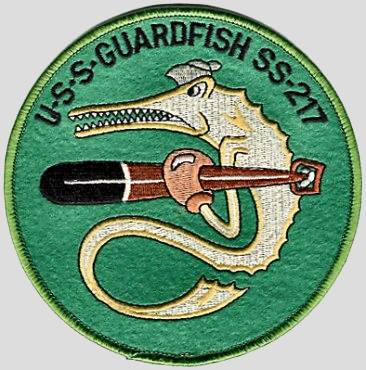
Patch contributed by Mike Smolinski
Guardfish (SS-217)
Unit Awards, Campaign and Service Medals and Ribbons
Presidential Unit Citation
Please report any broken links or trouble you might come across to the Webmaster.
Please take a moment to let us know so that we can correct any problems and make your visit as enjoyable and as informative as possible.

| Click On Image For Full Size | Size | Image Description | Source By |
|
|---|---|---|---|---|
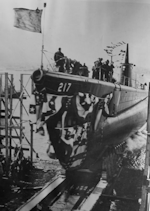 | 92k | Launching day for the Guardfish (SS-217) at the Electric Boat Co., Groton, CT.,20 January 1942 | Photograph courtesy of David Buell. | |
 |
211k | Commemorative postal cover marking the launching of the Guardfish (SS-217), at the Electric Boat Co., Groton, CT.,20 January 1942. | USN photo courtesy of Scott Koen & ussnewyork.com. | |
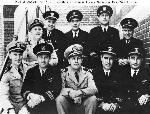 | 62k | U.S. Naval Submarine Base, New London, Groton, Connecticut: Members of the 4th Command Class at the Submarine Base, February 1942. Those present are, bottom row left to right: Lieutenant Commander Mannert L. Abele; first command would be the Grunion (SS-216). He would be K.I.A. while commanding the Grunion, 30 July 1942. Lieutenant Commander Thomas B. Klakring; first command would be the Guardfish (SS-217), Commander Karl G. Hensel, Officer in Charge; Lieutenant Commander George W. Patterson, Jr., Senior Assistant; and Lieutenant Commander Jesse L. Hull; first command would be the Finback (SS-230). Top row, left to right: Lieutenant Commander Howard W. Gilmore; first command would be the Growler (SS-215). He was posthumously awarded the Medal of Honor after he was K.I.A. on the bridge of the Growler, 7 February 1943. Lieutenant Commander Philip H. Ross; first command would be the Halibut (SS-232), Lieutenant Commander Arthur H. Taylor; first command would be the Haddock (SS-231), Lieutenant Commander Albert C. Burrows; first command would be the Swordfish (SS-193) and Lieutenant Commander Leonard S. Mewhinney; first command would be the Saury (SS-189). | Official USN photo # 80-G-88577, now in the collections of the National Archives. Courtesy of the USNHC. | |
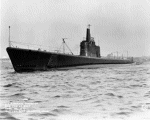 |
63k | Bow view at rest of the Guardfish (SS-217) at the Electric Boat Co., Groton, CT., 19 April 1942, three weeks before commissioning. | USN photo courtesy of Electric Boat. | |
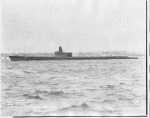 |
494k | 15 April 1942 finds the Guardfish (SS-217) at rest while the crew pays their dues at Electric Boat Co., Groton, CT. | Courtesy of John Hummel, USN (Retired). | |
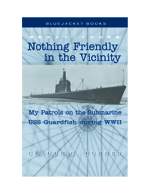 |
1.25k | Commissioning photo of the Guardfish (SS-217). | Photo & text courtesy of Claude Connor, author of Nothing Friendly in the Vicinity: My Patrols on the Submarine Guardfish During WWII. | |
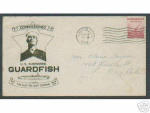 |
26k | Commemorative postal cover marking the commissioning of the Guardfish (SS-217) at the Electric Boat Co., Groton, CT., 8 May 1942. | Courtesy of Jack Treutle (of blessed memory). | |
 |
27k | Commemorative postal cover marking the commissioning of the Guardfish (SS-217) at the Electric Boat Co., Groton, CT., 8 May 1942. | Courtesy of Jack Treutle (of blessed memory). | |
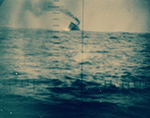 | 837k | Her first war patrol was in the hitherto unpatrolled waters off northeast Honshu. Guardfish (SS-217) departed Pearl Harbor 6 August 1942, sank a trawler 22 August, and 24 August sank 3,114-ton cargo ship Seikai Maru off Kinkasan Harbor. Evading escort vessels, she proceeded up the coast and found a convoy 2 September. Guardfish attacked the next day, sinking 5,253-ton Kaimei Maru and 1,118-ton cargo ship Tenyu Maru. Chita Maru a 2,376-ton freighter, retreated into the harbor and anchored, but a remarkable long-range shot from Guardfish left her resting in the mud. Guardfish returned to Midway from her spectacularly successful first patrol for refit 15 September 1942. Shown is a 9,000 ton freighter sunk 4 September 1942. | Text courtesy of DANFS. USN photograph # 80-G-13547, now in the collections of the National Archives courtesy of the National Museum of the U.S. Navy, via flickr.com. |
|
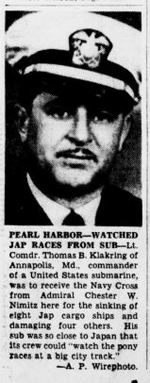 0821742 |
NR | PEARL HARBOR—WATCHED JAP RACES FROM SUB Lt. Comdr. Thomas B. Klakring of Annapolis, Md„ commander of a United States submarine, was to receive the Navy Cross from Admiral Chester W. Nimitz here for the sinking of eight Jap cargo ships and damaging four others. His sub was so close to Japan that its crew could “watch the pony races at a big city track." | A. P. Wirephoto. Image and text provided by Library of Congress, Washington, DC. Photo from Evening Star. [volume] (Washington, D.C.) 1854-1972, 01 December 1942, Image 1, via chroniclingamerica.loc.gov | |
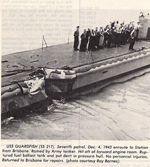 |
118k | Guardfish (SS-217) helps make a dent in the destruction of shipping in WW II. | USN photo courtesy of Scott Koen & ussnewyork.com | |
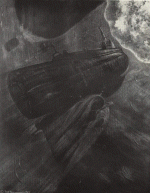 |
149k | Guardfish (SS-217) gets a "going over". Underwater explosion forms huge bubble and sends out percussion waves. Blast close aboard could crush pressure hull. Here the sub sustains a near miss. On same patrol, Guardfish watched a Honshu horse-race, sank 4 ships in a day, scored one of the wars longest torpedo shots. | Drawing by Lt. Cmdr. Fred Freemen, courtesy of Theodore Roscoe, from his book "U.S. Submarine Operations of WW II", published by USNI. | |
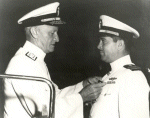 |
53k | Admiral Nimitz, Commander-in-Chief, US Pacific Fleet, presents the Navy Cross to LCdr Thomas B. Klakring, Commanding Officer of Guardfish (SS-217). | USN photo. | |
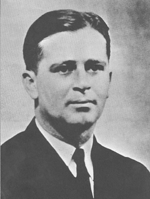 |
356k | Lt. Cmdr. Thomas B. Klakring. Born in Annapolis, Maryland on 19 December 1904, as the only child of Colonel and Mrs. Leslie Klakring, he entered the Naval Academy from the State of Connecticut, and graduated with the Class of 1927. A submarine hero of the Pacific War in World War II, Admiral Klakring was credited with sinking eight Japanese ships within sight of Japanese ports, after taking his submarine, Guardfish (SS-217), into Japanese water previously un-patrolled by American submarines. Without the benefit of sophisticated SONAR, Guardfish sighted, or torpedoed, 77 enemy vessels in about 35 days, during one of her war patrols. LCDR Klakring commanded Guardfish from 1941 to 1943. While under LCDR Klakring's command, Guardfish chalked up an impressive record. She left on her first war patrol on 6 August 1942 for the eastern shore of Honshu, and sent eight enemy ships, totaling 51,055 tons, to the bottom, and damaged a 7,000 ton freighter. In October, during her second war patrol, Guardfish sank another freighter and a tanker, and damaged another freighter in the East China Sea. On Guardfish's third war patrol, in the Rabaul-Kavieng area, additional Japanese shipping was sunk, including two naval vessels. For his heroism while commanding Guardfish, Klakring was awarded the Navy Cross with two Gold Stars (in lieu of second and third awards). In addition, Guardfish was awarded the Presidential Unit Citation while under Klakring's command. Admiral Klakring's other decorations include the Silver Star, Bronze Star (both for heroism during World War II), China Service Medal, American Defense Service Medal, American Area Campaign Medal, Asiatic-Pacific Area Campaign Medal, and the World War II Victory Medal. |
USN photo from the book: These Men Shall Never Die by Lowell Thomas (Philadelphia: John C. Winston Co.,1943), p. 90.) Text and photo submitted by Bill Gonyo. |
|
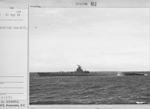 | 622k | Departing Brisbane for the same waters 2, May 1943, Guardfish (SS-217) sank 201-ton freighter Suzuya Maru and damaged another before being forced down by aircraft 13 June. She picked up a surveying party on the west coast of Bougainville 14 July and returned to Brisbane for refit 2 August 1943. Photo dated 21 May 1943, likely there is a mistake with with one of the dates as it is unlikely that the Guardfish would have the time to have a photo taken in the middle of her war patrol. | Text courtesy of DANFS. US National Archives photo # 80-G-394379 from National Archives and Records Administration (NARA), College Park, Maryland, courtesy of Sean Hert. |
|
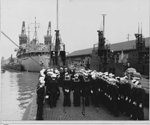 | 1.40k | Citation from Admiral Carpender aboard the Guardfish receiving their submarine combat insignia on 18 August 1943. The boats in the background are: Peto (SS-265) in the middle. Interesting that she still has the high bridge forward. She would depart on 9/1/43, so unless the tender did a quick cut down, she would have departed on patrol in September still with a high bridge. Even if they did cut it down before she departed, its interesting that she still had it as late as August. I had no idea they were splotching the periscopes that early, a great detail for modelers. Scamp (SS-277) to the right. Assuming the August 18 date is correct, that would match up. Scamp departed on patrol on September 2nd, so she would have been there. If the boat to her port is a high bridged type (hard to tell, but from the sailor peeking out of the dead light, maybe), then she would be Peto, who was likely the only high bridge type there, and probably the very last one. She would depart on September 2nd. Others in port at that time included Albacore (SS-218), Stingray (SS-186), Grouper (SS-214) and likely Gato (SS-212). All departed Brisbane between August 23rd and September 6th. Grouper is to the left in the background moored with the Fulton (AS-11). The boat to her starboard whose extreme stern is probably Tuna (SS-203). She had left for patrol before the awards ceremony date, but a friendly fire incident with an RAAF bird forced her back into Brisbane for repairs, so she had reentered port and didn't leave again until August 21st, 1943. She had the aft torpedo tube shutters as-built like the other Tambors, and like the mystery boat. It's hard to see and faint but the mystery boat appears to have the degaussing circuit on her stern. So did Tuna and at that precise place and time, too. | Majority text i.d. courtesy of Robert Morgan, with input from David Johnston (USN, retired) & John Hummel, USN (Retired). US National Archives photo # 80-G-394390 & 80-G-394401 from National Archives and Records Administration (NARA), College Park, Maryland, courtesy of Sean Hert. |
|
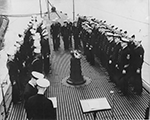 | 533k | Guardfish (SS-217) receives the Presidential Unit Citation from Vice Admiral Arthur S. Carpender commander of Allied Naval Forces in the Southwest Pacific. The Guardfish is credited with destroying more than 66,000 tons of Japanese shipping and damaging 14,000 aditional tons. Photo date filed 11 April 1944. | US National Archives photo # 80-G-44884 from National Archives and Records Administration (NARA), College Park, Maryland, courtesy of Sean Hert. | |
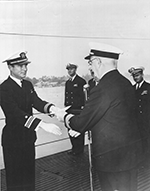 | 281k | Lt. Cmdr. N.G. Ward, skipper of the Guardfish (SS-217) accepts the Presidential Unit Citation. | US National Archives photo # 80-G-44885 from National Archives and Records Administration (NARA), College Park, Maryland, courtesy of Sean Hert. | |
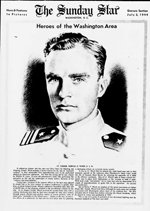 0821723 |
NR | LT. COMDR NORVAL G WARD, U. S N. Comdr. Ward perhaps is better known for his role of "assistant surgeon" in that memorable first appendectomy ever to be performed aboard an American submarine. For that life-saving job he was chosen by Wheller B Lipes, 23 year old pharmacist's mate who performed the operation as the sub lay submerged in enemy waters, because of his "coolness and dependability." Young Lipes' estimate of his superior officer as the best man aboard to steady him in his first venture in surgery emphasizes a quality that later no doubt helped Comdr. Ward's submarine Guardfish (SS-217) take that toll of 66,000 tons of Jap shipping extolled in the presidential citation for his ship as its skipper, Comdr. Ward received his second Silver Star with a citation disclosing also that he had twice brought his ship close inshore through poorly charted and perilous waters to rescue persons, some of whom were invaluable to the Allied cause' Earlier in the war, as executive officer of a submarine, he had won his first Silver Star for planning a damaging attack on escorted enemy vessels. | Image and text provided by Library of Congress, Washington, DC. Photo from Evening Star. [volume] (Washington, D.C.) 1854-1972, 02 July 1944, Image 37, via chroniclingamerica.loc.gov | |
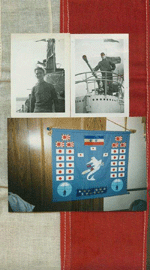 |
650k | The red-white background is my piece of the Homeward Bound Pennant". Photo on the top-left is me, top-right is Clay Blair. Color photo is our "Battle Flag," claiming 26 ships sunk by torpedoes; 20 merchant ships, 6 War Ships. The small Japanese flags represent 3 small-craft sunk by deck-gun action. Top-center represents our 2 Presidential Unit Citations. | Photo & text courtesy of Claude Connor, author of Nothing Friendly in the Vicinity: My Patrols on the Submarine Guardfish During WWII. | |
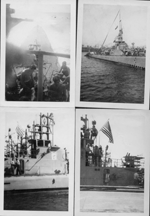 |
971k | The one on the top-right is Guardfish (SS-217) at Pearl Harbor Sub Base, preparing to return to the States. The long banner from the raised periscope toward the stern is the red-white "Homeward-bound Pennant" that has an inch of length per months overseas per crew-member. The photo on the left is a view over the stern on our way home, looking down on the after-cigarette deck. I'm the closest guy on the left. Bottom-left view shows the high-lookout "cage" aft of the #2 periscope at the level of the Loop antenna located between the periscopes. That's the Lookout position I had when the boat almost left me to swim because I didn't hear the diving alarm when it submerged (see pages 25-26 in my book). | Photo & text courtesy of Claude Connor, author of Nothing Friendly in the Vicinity: My Patrols on the Submarine Guardfish During WWII. | |
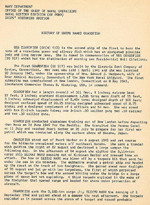 |
5.75k | 65 page PDF of Guardfish's (SS-217) history & war patrols. | USN photo courtesy of Scott Koen & ussnewyork.com. | |
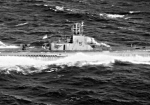 | 64k | A close up of a early construction government built Gato class submarine with only part of it's hull number painted on the sail, and a symbol possibly reminiscent of the Guardfish (SS-217). The number painted on the conning tower probably indicates its squadron, # 5 (?), which if it was during WW II would make it in the Atlantic. It may have been taken off Pensacola in the summer of 1944, or somewhere in the Pacific during 1945 or early 1946. | USN photo courtesy of Ivan van Meter, submitted by Jack LaPeer courtesy of Fabio Peña. Photo i.d. courtesy of Dave Johnston USN (Retired) & John Hummel, USN (Retired). | |
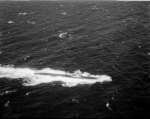 | 89k | High altitude photo of a Gato/Balao class submarine. It may have been taken off Pensacola in the summer of 1944, or somewhere in the Pacific during 1945 or early 1946. | USN photo courtesy of Ivan van Meter, submitted by Jack LaPeer courtesy of Fabio Peña. Photo i.d. courtesy of Dave Johnston & John Hummel, USN (Retired). | |
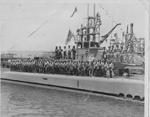 |
397k | Guardfish (SS-217) & crew photo at the end of WWII. | Photo courtesy of David "Hutch" Hutchinson, MOMM 1st Class, SS 217 via Paul S. Hobbs, Submarine Veteran ET1 (SS), Thomas Jefferson SBN 618. | |
 | 140k | Five Atlantic Reserve Fleet subs in mothballs at New London CT., late 1940's: Pompon (SS-267), Gunnel (SS-253), Whale (SS-239), Lapon (SS-260) and unidentified sub, probably the Guardfish (SS-217) or Dace (SS-247). | Text courtesy of David Johnston (USN, retired) Photo courtesy of John Hummel, USN (Retired). | |
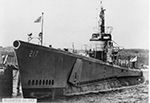 | 796k | Guardfish (SS-217) moored, probably in 50's at Subase New London, while she was a NRT Trainer. An interesting feature, check out the railings around the forward bridge gun position. Part of it has an X arrangement. I've never seen that before. Its in one or two other pics of Guardfish, but not as clear as this. | Photo courtesy of Robert Morgan. | |
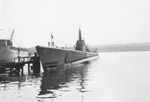 |
445k | Guardfish (SS-217) moored, in 50's at Subase New London, while she was a NRT Trainer. | USN photo courtesy of Don McPherson via ussubvetsofworldwarii.org. Text i.d. courtesy of Ron Reeves (of blessed memory). |
|
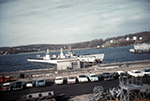 |
998k | From left to right: Unnumbered sub, Manta (SS-299) & Flasher (SS-249), Sub Base New London at the north end of the base. Unnumbered submarine is Guardfish (SS-217). She was in the New London Reserve Fleet for a long time before being expended. The masting looks the same as her latewar appearance, but a few features strongly suggest her. The forward gun platform has a turned down spray shield, as Guardfish did. The railings around that platform have stiffeners in an "X" pattern, as did Guardfish . There is also an elliptical vertical "barrel guard" at the front top of that railing to stop the 20mm gun crew from firing downwards and forward, probably to protect anyone on the forward main deck which Guardfish had late/end of war. Although difficult to tell for sure, the venturi appears the same shape, and the railings around the lookout platform atop the shears similarly look "splayed out." The date is between late 1959, (based on early model year car sales for the blue 1960 Chevy Bellaire parked in center foreground) and October 1961, when Guardfish was sunk as a torpedo target in Long Island Sound off New London, Connecticut, by the submarines Dogfish (SS-350) and Blenny (SS-324). |
Photo courtesy of Peter Greis via Fabia Pena. Photo i.d. courtesy of Ric Hednan & Robert Morgan. | |
| Back To The Main Photo Index | Back To the Submarine Index |
|
Problems and site related matters, E-mail Webmaster |
|
This page is created by Gary Priolo, and maintained by Michael Mohl All Pages © 1996 - 2025 NavSource History All rights reserved. |